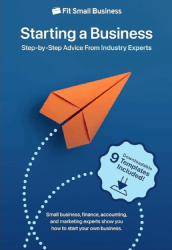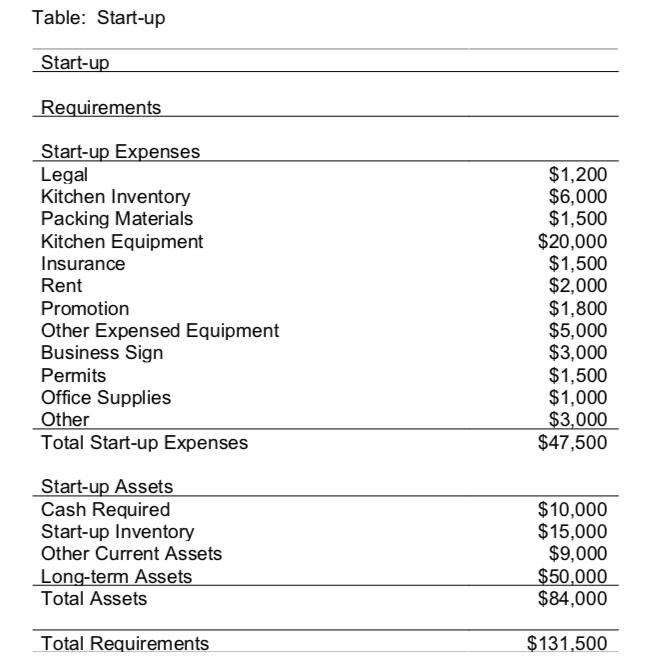A solid business plan helps you forecast your future business and is a critical tool for raising money or attracting key employees or business partners. A business plan is also an opportunity to show why and how your business will become a success. Learning how to write a business plan successfully requires planning ahead and conducting financial and market research.
How to write a business plan step-by-step:
- Gather your information
- Outline your business plan
- Write each section
- Organize your appendix
- Add final details
- Add a table of contents
- Get feedback.
Step 1: Gather Your Information
Your first step is to get organized by gathering all your relevant business information. This will save you time completing the various sections of your business plan. At a minimum, you’ll want to have the following handy:
- Business name, contact information, and address
- Owner(s) names, contact information, and addresses
- Names, contact information, and addresses of any business partners (if you will be working with partners)
- Resume and relevant work history for yourself and any key partners or employees
- Any significant sales, commerce, traffic, and financial data and forecasts
- Customer data (if applicable)
- Any significant data about your nearest competitors’ commerce, traffic, or finances
Step 2: Outline Your Business Plan
Now it’s time to outline your business plan, making note of the sections you need to include and what data you want to include in each section. You can create an outline on your own or use a business plan template to help. Whichever route you choose, it is common to include these sections in your business plan outline:
- Introduction
- Executive summary
- Company overview
- Products and services
- Market and industry analysis
- Marketing strategy
- Sales strategy
- Management and organization
- Financial data, analysis, and forecasts
Connect the data you gathered in step one to specific sections of your outline. Make a note if you need to convert some information into charts or images to make them more compelling for potential investors. For example, you’ll want to include relevant work history in your management section and convert your sales forecasts into charts for your financial data section.
Step 3: Write Each Section
Now it’s time to write your business plan. Attack this one section at a time, adding the relevant data as you go.
The executive summary is an overview of the business plan and should ideally be one, but no more than two, pages in length. Some investors actually only request the executive summary. So make it an informative, persuasive, and concise version of your business plan.
It can be easier to write the executive summary last, after the other sections. Then you can more clearly understand which sections of your business plan are the most important to highlight in the executive summary.
When learning how to write an executive summary for a business plan, remember to include the following:
- Business objectives: Your business objectives are specific and attainable goals for your business. Create at least four business objectives organized by bullet point. If you’re not sure how to phrase your objectives, read our SMART goals examples to understand how to do so.
- Mission statement: The mission statement discusses the aim, purpose, and values of your business. It’s typically a short statement from one sentence to several sentences in length. You may find that your mission statement evolves as your business grows. Learn more on how to write your mission statement in our guide.
Consider also including the following in your executive summary:
- Business description: Similar to a 30-second pitch, describing your business and what makes it unique
- Products and services: The type of products and services you’re providing and their costs
- Competitors: Your biggest competitors and why your business will succeed despite them
- Management and organization: The owners’ backgrounds and how they will help the business succeed; management structure within the business
- Business location (or facility): Location benefits and the surrounding area
- Target market and ideal customer: Who your ideal customers are and why they’re going to purchase your products or services
- Financial data and projections: Provide brief financial data and projections relevant to your business, such as startup costs, at what month the business will be profitable, and forecasted sales data
- Financing needed: Explanation of the startup funding sources and the amount of financing being requested
The bullets above can be combined into several paragraphs. You can add or remove sections based on your business’ needs. For example, if you don’t have a physical location, you might remove that piece of information. Or, if a web presence is crucial to your success, include two to three sentences about your online strategy.
The company overview (sometimes also called a “business overview”) section highlights your company successes (if you’re already in business) or why it will be successful (if you’re a startup). In the opening paragraph or paragraphs, provide information like location, owners, hours of operation, products, and services.
How you structure this section depends on whether you’re a startup or an established business. A startup will discuss the general expenses and steps needed to open the business, such as permits, build-outs, rent, and marketing. An established business will briefly discuss the company’s financial performance over the past three years.
If you’re trying to raise capital from an investor or bank, include a chart listing the items your business will acquire with the capital. For example, if you’re purchasing equipment with the additional funding, list each piece of equipment and the associated cost. At the bottom of the chart, show the total of all expenses, which should be the requested amount of funding.
This startup cost table for a pizza restaurant separates startup expenses from startup assets.
Your company overview should cover the following:
- Location & Facilities: If you have a brick-and-mortar location or a facility, like a warehouse, describe it here. Detail the benefits of your location and the surrounding areas. Write about square footage, leases or ownership, the surrounding area, and a brief description of the population.
- Ownership: Briefly mention the company ownership team and their backgrounds. Show why these owners are likely to be successful in operating this business by providing certain details, such as each owner’s industry experience, previous employers, education, and awards. This will be discussed more in-depth in the management and organization section below.
- Competitive advantage: Ideally, your competitive advantage is what your business can do that your competitors cannot. It’s the one big differentiator that will make your company successful. Many investors are looking for specific competitive advantages, such as patents, proprietary tech, data, and industry relationships. If you don’t have these, describe the top aspect in which your business will do better than competitors, such as quality of products, quality of services, relationships with vendors, or marketing strategy.
The products and services section is the most flexible section because its structure depends on what your business sells. Regardless of what you’re selling, include a description of your business model to explain how your business makes money. Also include future products or services your business could provide one, two, or five years down the road.
List and describe all physical and digital products you plan to sell, as well as any services the business provides. Services don’t necessarily have to be sold for a cost—your business might offer entertainment, like live music or bar games as a free service.
Whether you’re selling products, services, or both, it’s important to discuss fulfillment, or how each will be delivered. If you make or sell physical products, describe how products will be sold, assembled, packed, and shipped. If your business is service-based, describe how a service, such as a window installation, will be ordered and completed. Where will the glass be purchased from and acquired, how will customers place orders, and how will the window be installed?
The market and industry analysis section is where you analyze potential customers and the forces that influence your industry. This section is where you make the case as to why your business should succeed, ideally backed by data. You’ll want to do a deep dive into your competitors and discuss their challenges and successes. Learn more about sales targeting to improve how you approach your sales strategy.
Market Segmentation
Market segmentation, or your target market, consists of the customers who are most likely to purchase your products or services. Describe these groups of customers based on demographics, including attributes like age, income, location, and buying habits. Additionally, if you’ll be operating with a business-to-business (B2B) model, use characteristics to describe the ideal businesses to which you’ll sell.
Once your target market is segmented into groups, use market research data to show that those customers are physically located near your business (or are likely to do business with you if you’re online). If you’re opening a daycare, for example, you’ll want to show the data on how many families are in a certain mile radius around your business. You can obtain this kind of data from a free resource, like the U.S. Census and ReferenceUSA.
Once you have at least three segments, briefly outline the strategy you’ll use to reach them. Most likely it will be a combination of marketing, pricing, networking, and sales.
Learn the best approach to product pricing in our guide.
Industry Analysis
Take a look at your business’s industry and explain why it’s a great idea to start a business in that niche. If you’re in a growing industry, a bank is more likely to lend your business capital because it’s predicted to be in demand and have additional customers. Learn about how to find a niche market.
Find industry statistics from a free tool, like the Bureau of Labor Statistics, or a paid tool like the Hoovers Industry Research, which provides professionally curated reports for over 1,000 industries.
Competitor Research
Wrap up the market and industry analysis section by analyzing at least five competitors within a five-mile radius (expand the radius, if needed). Create a table with the five competitors and mention their distance from your business (if applicable), along with their challenges, and successes.
During your analysis, you’ll want to frame their challenges as something you can improve upon. Persuade your reader that your business will provide superior products and services than the competitors.
In the opening paragraphs of your marketing strategy and implementation summary, give an overview of the subsections below.
Include any industry trends you may take advantage of. If applicable, include the advertising strategy and budget, stating specific channels. Mention who in the business will be responsible for overseeing the marketing.
Include any platforms and tools the business will use, like your website, social media, email marketing, and video. If you’re hiring a company to do any online work, like creating a website or managing social media, briefly describe them and the overall cost (you can elaborate more on costs in the financial data section).
Don’t forget to include a subsection for your traditional marketing plan. Traditional marketing encompasses anything not online, such as business cards, flyers, local media, direct mail, magazine advertising, and signage.
Sales Strategy
If sales is an important component of your business, include a section about your sales strategy. Describe the role of the salesperson (or persons), strategies they’ll use to close the deal with clients, lead follow-up procedures, and networking they’ll attend. Also, list any training your sales staff will attend.
Sales Forecast Table
A sales forecast table gives a high-level summary of where you expect your sales and expenses to occur for each of the next three years in business. In the paragraph before the table, state where you expect growth to come from and include a growth percentage rate. The annual sales forecast chart will be broken down further in the financial projections section below.
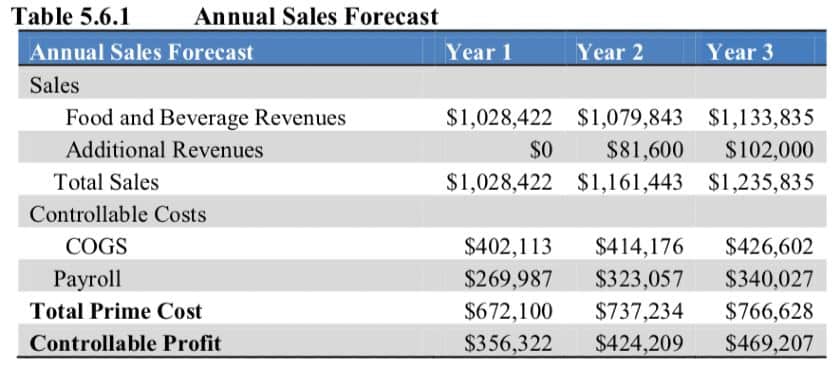
The annual sales forecast for this restaurant summarizes sales, cost, and profit for the first three years in business.
Pricing Strategy
In the pricing strategy section, discuss product/service pricing, competitor pricing, sales promotions, and discounts—basically anything related to the pricing of what you sell. You should discuss pricing in relation to product and service quality as well. Consider including an overview of pricing for specific products, e.g., pizza price discounts when ordering a specific number of pizzas for catering.
Milestones
Milestones in a business plan are typically displayed in a table. They outline important tasks to do before the business opens (or expands, if already in business). For each milestone, include the name, estimated start and completion date, cost, person responsible, and department responsible (or outside company responsible). List at least seven milestones.
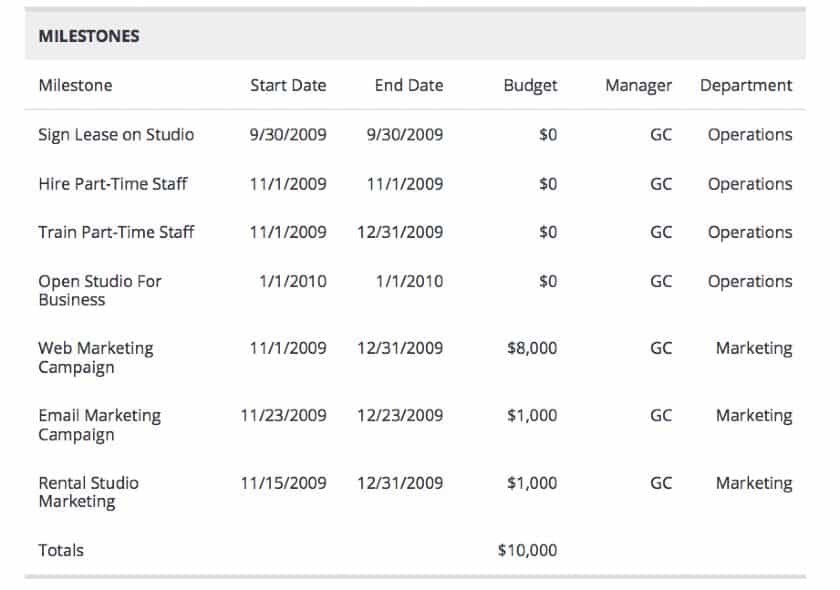
Milestones for this commercial photography business include hiring staff and completing marketing campaigns.
The management and organization summary is an in-depth look at the ownership background and key personnel. This is an important section because many investors say they don’t invest in companies, they invest in people. In this section, make the case why you and your team have the experience and knowledge to make this business a success.
Ownership Background
Discuss the owners’ backgrounds and place an emphasis on why that background will ensure the business succeeds. If you don’t have experience managing a retail business, consider finding a co-owner who does. Typically, banks won’t lend to someone who doesn’t have experience in the type of business they’re trying to open.
Management Team Gaps
If there are any experience or knowledge gaps within the management team, state them. List the consultants or employees you will hire to cover the gaps. Investors who know your industry well may recognize gaps within your business plan, and it’s important to state the gaps without waiting for the investor to bring it up. This makes it appear that you know the industry well.
Personnel Plan
The personnel plan outlines every position within your business for at least the next three years. In the opening paragraph, discuss the roles within the company and who will report to whom. Include a table with at least three years of salary projections for each employee in your business. Include a total salary figure at the bottom. This table may be broken down further into salaries for each month in the financial projections or appendix.
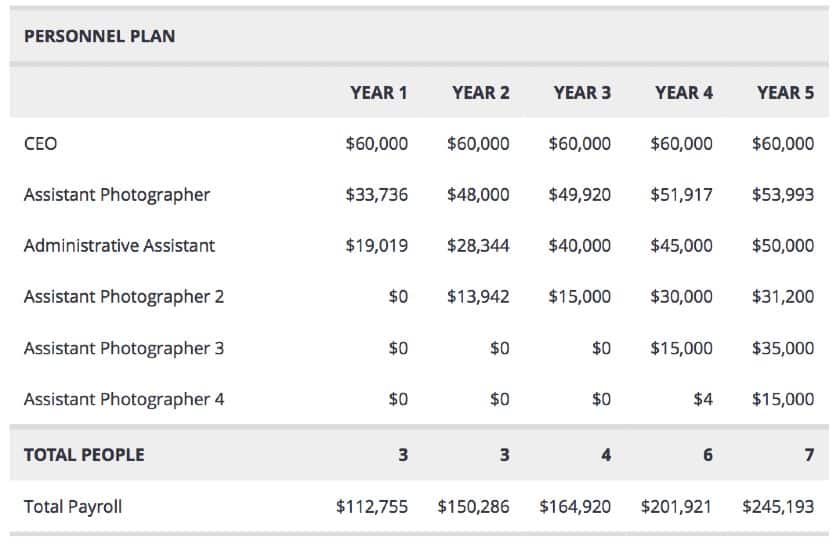
This commercial photography business has the CEO at the same salary every year, with their employees’ salaries increasing year over year.
The financial data and analysis section is the most difficult part of a business plan. This section requires you to forecast income and expenses for the next three years. You’ll need a working knowledge of common financial statements, like the profit and loss statement, balance sheet, and cash flow statement.
In the opening paragraphs of the financial data and analysis section, give an overview of the sections below. Discuss the break-even point and the projected profit at the first, second, and third year in business. State the assets and liabilities from the projected balance sheet as well.
If you’re getting a loan from a bank, say how long and from what source the loan will be repaid. One of the main pieces of information bankers want to ascertain from financial forecasting is if they will be paid back and how likely that is to happen.
You might also include the following financial reports:
- Break-even analysis: Break-even is when your business starts to make money. Break-even analysis is where you illustrate the point at which your revenue exceeds expenses and a profit occurs. In this section’s opening paragraph, state your monthly fixed costs and average percent variable costs (cost that changes with output, like labor or cost of goods). In the example below, variable costs increase 8% for every additional dollar made.
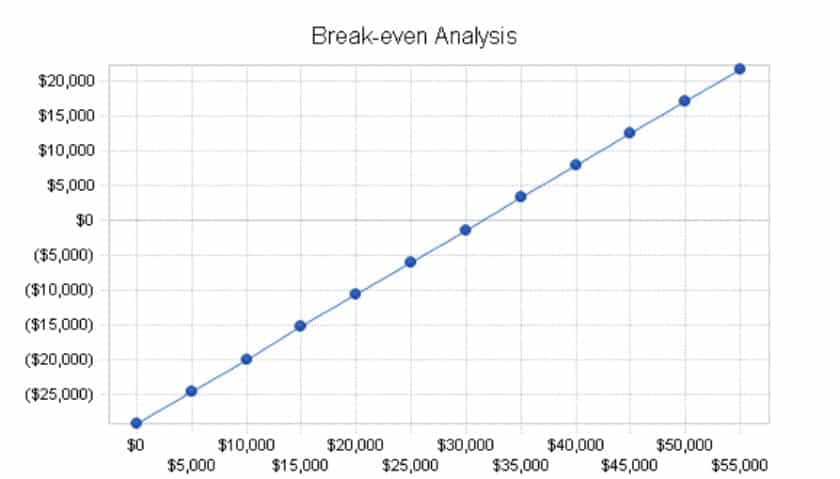
The break-even point for this document shredding business is $31,500 in a month.
- Projected profit & loss: The profit and loss table is a month-by-month breakdown of income and expenses (including startup expenses). Typically, you should expect your business to show a profit within the first year of operating and increase in years two and three. Be sure to show income and expenses month-by-month for the first two years in operation. Create a separate chart that shows income and expenses year-by-year for the first three years.
- Projected cash flow: The cash flow section shows your business’s monthly incoming and outgoing cash. It should cover the first two years in business. Mention what you plan to do with excess cash. See how to run a statement cash flow in QuickBooks Online.
- Projected balance sheet: The balance sheet shows the net worth of the business and the financial position of the company on a specific date. It focuses on the assets and liabilities of the business. Ideally, the balance sheet should show that the net worth of your business increases. Prepare a projected year-by-year balance sheet for the first three years.
- Business ratios: Also called financial ratios, these are a way to evaluate business performance. It’s helpful to compare your projected business ratios to the industry standard. Project your business ratios by year for the first three years.
Step 4: Organize Your Appendix
The appendix is where you put information about the business that doesn’t fit in the above categories. What you put here largely depends on the type of business you’re creating. It’s a good idea to put any visual components in the appendix. A restaurant might add an image of the menu and an artist rendering of the interior and exterior, for example.
Consider including the following items in your business plan appendix:
- Artist mock-up of interior
- Building permits
- Equipment documentation
- Floor plan
- Incorporation documents
- Leases and agreements
- Letters of recommendation
- Licenses and permits
- Marketing materials
- Media coverage
- Supplier agreements
- Trademarks
An appendix isn’t required in a business plan, but it’s highly recommended for additional persuasion. Documents like media coverage, agreements, and equipment documentation show the investor and banker you’re serious about the business. If your appendix is more than 10 pages, consider creating a second table of contents just for the appendix.
Detailed Financial Projections
Put the more detailed projections in the appendix. The financial projections in the previous section is typically a year-by-year breakdown for three years in the future. But many bankers and investors want to see the first two years broken down month-by-month for at least the profit and loss statement, balance sheet, cash flow, and personnel plan.
Typically, you can print out the spreadsheet in smaller font and include it in the appendix. You don’t need to create additional charts for the appendix.
Step 5: Add Final Details
With all of your information organized, now it’s time to add the final details, like cover pages and a nondisclosure agreement (NDA).
- Cover Page: The cover page provides contact information about the business and its owner. The cover page should have the business name and who prepared it, including your name, address, phone number, and email address. Additionally, if the registered company name with the state is different from the business name, you may want to add that as a “company name.”
- Nondisclosure Agreement: An NDA ((also called a confidentiality agreement) is a legal document that safeguards business information. You’d want someone to sign it before reading your business plan if you believe they could use the information to their advantage and your disadvantage, such as to steal your business idea or marketing strategy.
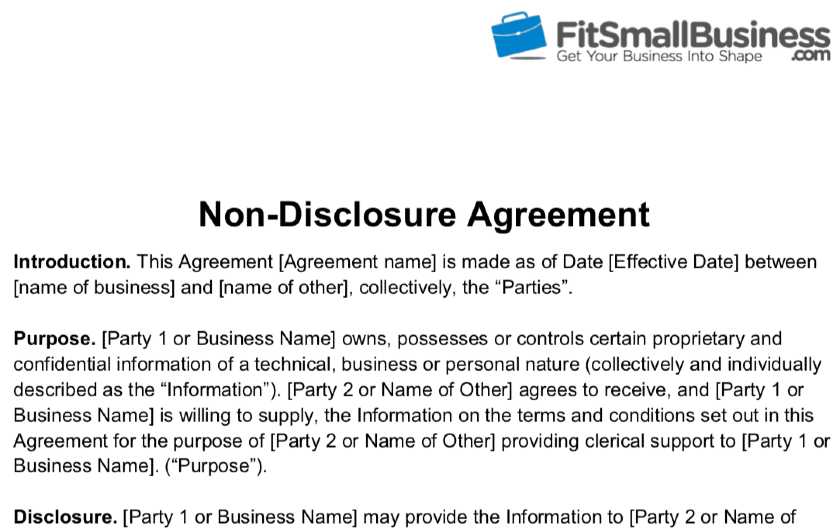
Fit Small Business provides a free non-disclosure agreement.
Once your final details are added, proofread all the sections of your business plan, ensuring that the information is accurate and that all spelling and grammar are correct. If there are any illustrations, projections, or additional information you forgot to include, now is the time to add it.
Step 6: Add a Table of Contents
The final step is adding a table of contents so that bankers and potential investors can easily navigate your business plan. A table of contents lists the sections and subsections of your business plan. All of the headers above (Executive Summary, Business Objectives, Company Overview, Products and Services, and so on) are considered sections of a business plan. You can number the sections for additional organization. For example, 1.0 is the executive summary, 1.1 is the business objectives, and 1.2 is the mission statement.
Editing and formatting can change the pagination of your business plan. So you’ll save yourself work if you finalize the business plan content first, then arrange the table of contents at the end.
Step 7: Get Feedback
Congratulations! You’ve captured your business idea and plan for profitability on paper. Before you send this business plan to loan officers and potential investors, ask friends, family, and other supportive business owners to read it and provide feedback. They may notice typos or other errors that you missed. They may also identify details you can add to make your business plan more persuasive.
Frequently Asked Questions (FAQs) About How to Write a Business Plan
These are the most common questions I hear about writing a business plan.
What you should put in a business plan depends on its purpose and your industry. If you’re seeking funding from a bank or investor, you’re going to need most of the sections above, with a strong focus on your financial projections. If you are using your business plan to attract key employees (like a chef for your restaurant), mock-ups and vendor agreements will be more useful. Think about the information that will help your target reader make a decision about whether to get involved with your business—whether that is a location, a business model, or product idea—and be sure your business plan includes that information.
The business plan for a startup is similar to a business plan for an established business. The startup business plan will include startup costs, which will be listed by item and factored into the financial projections. Additionally, since your business hasn’t proven it can be successful yet, you may need additional information about the ownership, business model, market, and industry to convince the reader your business will succeed.
A simple business plan may only take a couple of hours. However, for the business plan provided with this template, which includes financial projections, it may take over 60 hours to research the income and costs associated with running your business. You also have to format those costs into a chart, because it’s best to showcase the data with easy-to-understand charts.
Creating a business plan for funding from a bank or investor is a detailed process. Unless you have a background in financial statements, the financial projections may be difficult for the average business owner. But you can ask for help; it is common to hire a bookkeeper or accountant to assist you with financial projects to ensure your math is correct. Outside of the projections, most other business plan sections are simple, though you’ll want to give yourself time to make each section persuasive.
Bottom Line
Every type of business, whether it’s a side hustle or a multimillion-dollar business, should have a business plan. The industry analysis and market segmentation sections validate your business idea. Researching and forecasting financial projections helps you logically think through income and expenses, which lessens the risk of business failure. Remember to get feedback on your business plan from business employees and associates. If necessary, have them sign an NDA before they review the plan.
